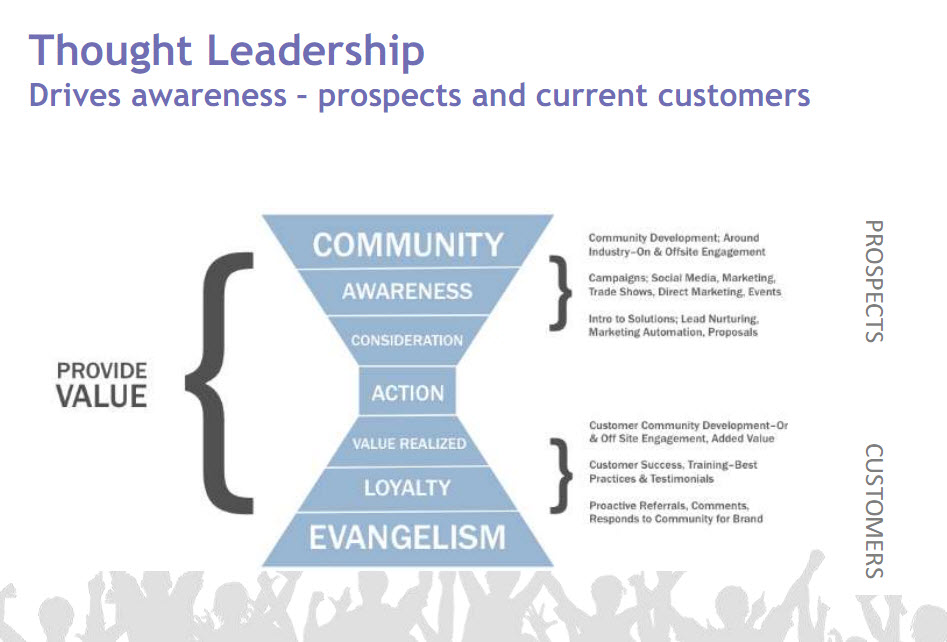The Forbes platform, generates hundreds of articles daily and is supported not only by its high caliber journalists but also a hand-picked community of 1300 contributors as well as a small number of well-known brands producing thought leadership content. This content is so highly valued that it still generates traffic, even if it is at least 30 days old. So what exactly is thought leadership? As a buzzword it is open to interpretation and can be slightly misused and understood. All brands have to get to grips with content marketing and thought leadership is a key component to that strategy.
Daniel Rasmus in a Fast Company article provided this definition:
“Thought leadership should be an entry point to a relationship. Thought leadership should intrigue, challenge, and inspire even people already familiar with a company. It should help start a relationship where none exists, and it should enhance existing relationships”.
Daniel makes the point that all firms regardless of size want to be included in the thought leadership club. He says thought leadership requires a consistent diligent effort. The process is cumulative, and should always intrigue, challenge and inspire fans and customers alike.
To include thought leadership in your content strategy, businesses need to generate new ideas or at least provide fresh insights into old ones. It helps to identify key personalities or company spokespersons who can clearly be identified as the voice of the company. The many companies are highly protective of offending their customers or clients, this is natural but is important to ensure that thought leadership offers the audience, a definitive point of view. This means taking certain risks that many businesses are not prepared to take especially those in the financial services sector. It’s important to remember, that thought leadership is about providing insights. Leave factual reporting to the journalists. Don’t be afraid to take a unique perspective and interpret it for your audience.
Planning and creating thought leadership strategy, should include ideas that are aligned to the needs of the audience that you’re trying to reach. There is little point in producing thought leadership if no one is going to read it, your efforts therefore need to assist readers with their life or occupation. Premium thought leadership helps professionals within an industry or certain roles within an industry. For example CIOs or CMO‘s gain insight, and provide a better understanding for their market. I can imagine a manufacturer talking to a FinTech specialist about you guessed it.. Manufacturing, would probably draw a glazed over expression. However if one connected the dots with cloud technology, digitalisation, smart devices and the fusion between man and machinery mighty for a different reaction. (Hopefully) it’s all about crafting the message.
The best thought leadership is credible, audiences will be able to pick up on that within less than a minute. Thought leadership also doesn’t limit itself to the present but is always looking towards the future. Content that is geared towards interpreting the reams of data that we are all inundated with and used to forecast future trends is a good way to raise the bar. If you want to make the transition from business leader to thought leader, you have to be known more for your observations and interactions, than for how you execute business strategy. It is the value that you bring to others that gains you the title, make no mistake however it takes a lot of hard work.
Image credit: marketo.com

Hayden Richards is Contributor of IntelligentHQ. He specialises in finance, trading, investment, and technology, with expertise in both buy-side, sell-side. Contributing and advising various global corporations, Hayden is a thought leader, researching on global regulatory subjects, digital, social media strategies and new trends for Businesses, Capital Markets and Financial Services.
Aside from the articles, interviews and content he writes for IntelligentHQ, Hayden is also a content curator for capital markets, analytic platforms and business industry emerging trends. An avid new media explorer Hayden is driven by a passion for business development, innovation, social business, Tech Trading, payments and eCommerce. A native Trinidadian, Hayden is also a veteran, having served with the Royal Air Force Reserves for the past 10 years.
Follow Hayden on Twitter @HaydenARichards, linkedin.com/haydenhrichards and http://www.scoop.it/u/hayden-richards











